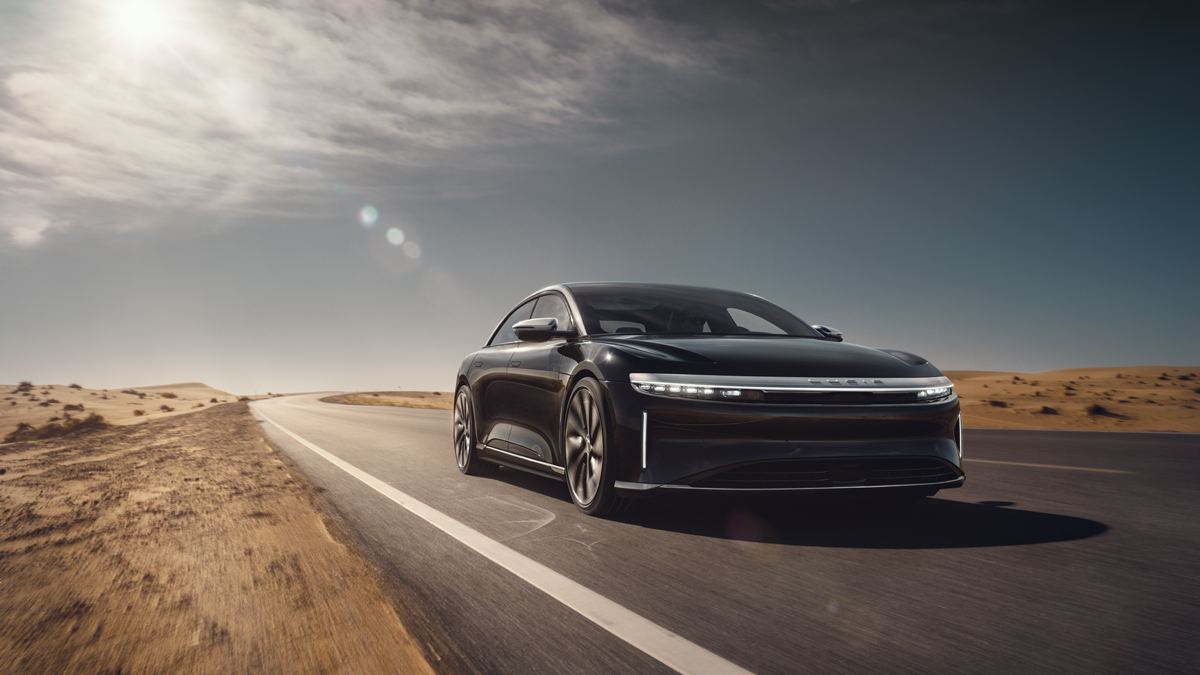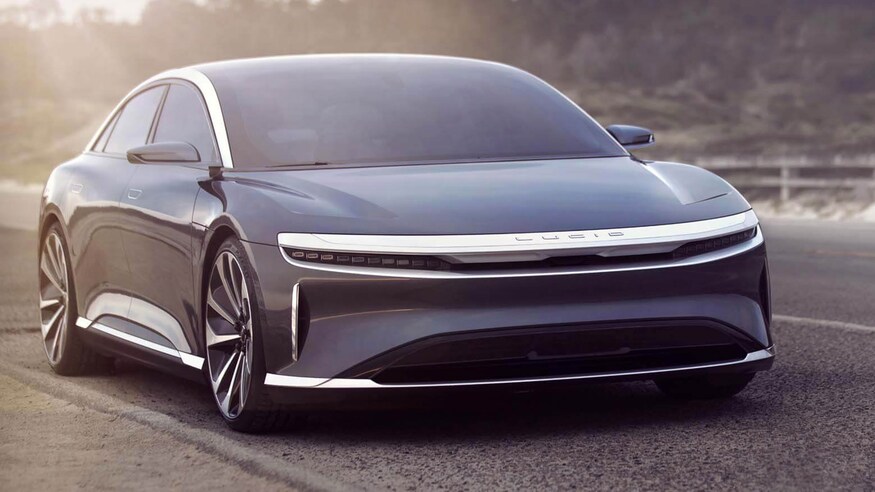

News
Lucid Motors sees Tesla as an ally, “Please don’t describe us as a Tesla Killer”
After Tesla established itself as the leader in electric vehicle manufacturing, it became common for the biggest names in the automotive industry to claim that they are coming up with a car that would knock the Elon Musk-headed company off its prolific pedestal. However, self-deemed “Tesla Killers” have consistently fallen short, lacking battery technology, performance, or both, in a quest to compete with the “who’s who” of EV production.
Lucid Motors’ “Air,” a vehicle that claims a 400-mile range and exceptional 1,000+ horsepower setup with a 235 mph top speed, is one of these vehicles. However, it’s not the manufacturer claiming that their car can beat Tesla and “kill” the company’s momentum. In fact, Lucid CEO and CTO Peter Rawlinson, a former Tesla executive, is spreading encouragement to his past employer.
“The world’s big enough that we can both thrive and prosper alongside each other,” Rawlinson said in an interview with Ars Technica. He also explicitly stated that being a “Tesla Killer” is not appropriate for Lucid or its goals.
“Please don’t describe us as a Tesla Killer,” Rawlinson remarked.

Competition is what makes most industries flourish. A constant need to prove one product is better than another is what pushes technological advancements, especially in the automotive sector. While a necessity, cars are supposed to be fun. If they weren’t, they wouldn’t have all the bells and whistles and features that consumers love. Tesla, for example, has Fart Mode. While fun and humorous, does anyone need it? Absolutely not, but it’s something that’s just fun to have.
Tesla continues to dominate electric vehicle sales in nearly every country across the world because of its technology and performance. The company’s vehicles offer more range than any other EV on the market, and the company’s release of a million-mile battery is getting closer. The speed and acceleration that come with the impressive battery range are also a significant selling point for some of those who require a little bit of an adrenaline rush when pushing the accelerator.
Rawlinson accepts all of these points and agrees that Tesla is at the head of the pack.
“It’s a justifiable comparison in one respect, because I think that Tesla is undeniably the leader in electric powertrain technology today,” he told Jonathan Gitlin of Ars Technica. “The most important thing here is efficiency, and we’re chasing down four miles per kilowatt-hour for our car.”
Lucid is aiming to build a quality product, and they’re taking their time doing it. While the Air was unveiled in 2017, it was more influenced by the Mercedes-Benz S-Class than the Tesla Model S. The car will be built at the company’s plant in Casa Grande, Arizona, which is still under construction but is near completion.
Lucid has also opened up its market to the Middle East, aiming to spread its tech to the countries of Saudi Arabia and the United Arab Emirates.
Elon Musk once said that no electric vehicle is a Tesla competitor, because each electric car accelerates the transition to sustainable energy. The real enemy is the internal combustion engine manufacturers who continue to harm the environment.
It seems Musk’s old colleague has joined this mentality.

Elon Musk
Elon Musk and Tesla AI Director share insights after empty driver seat Robotaxi rides
The executives’ unoccupied tests hint at the rapid progress of Tesla’s unsupervised Robotaxi efforts.

Tesla CEO Elon Musk and AI Director Ashok Elluswamy celebrated Christmas Eve by sharing personal experiences with Robotaxi vehicles that had no safety monitor or occupant in the driver’s seat. Musk described the system’s “perfect driving” around Austin, while Elluswamy posted video from the back seat, calling it “an amazing experience.”
The executives’ unoccupied tests hint at the rapid progress of Tesla’s unsupervised Robotaxi efforts.
Elon and Ashok’s firsthand Robotaxi insights
Prior to Musk and the Tesla AI Director’s posts, sightings of unmanned Teslas navigating public roads were widely shared on social media. One such vehicle was spotted in Austin, Texas, which Elon Musk acknowleged by stating that “Testing is underway with no occupants in the car.”
Based on his Christmas Eve post, Musk seemed to have tested an unmanned Tesla himself. “A Tesla with no safety monitor in the car and me sitting in the passenger seat took me all around Austin on Sunday with perfect driving,” Musk wrote in his post.
Elluswamy responded with a 2-minute video showing himself in the rear of an unmanned Tesla. The video featured the vehicle’s empty front seats, as well as its smooth handling through real-world traffic. He captioned his video with the words, “It’s an amazing experience!”
Towards Unsupervised operations
During an xAI Hackathon earlier this month, Elon Musk mentioned that Tesla owed be removing Safety Monitors from its Robotaxis in Austin in just three weeks. “Unsupervised is pretty much solved at this point. So there will be Tesla Robotaxis operating in Austin with no one in them. Not even anyone in the passenger seat in about three weeks,” he said. Musk echoed similar estimates at the 2025 Annual Shareholder Meeting and the Q3 2025 earnings call.
Considering the insights that were posted Musk and Elluswamy, it does appear that Tesla is working hard towards operating its Robotaxis with no safety monitors. This is quite impressive considering that the service was launched just earlier this year.
Elon Musk
Starlink passes 9 million active customers just weeks after hitting 8 million
The milestone highlights the accelerating growth of Starlink, which has now been adding over 20,000 new users per day.

SpaceX’s Starlink satellite internet service has continued its rapid global expansion, surpassing 9 million active customers just weeks after crossing the 8 million mark.
The milestone highlights the accelerating growth of Starlink, which has now been adding over 20,000 new users per day.
9 million customers
In a post on X, SpaceX stated that Starlink now serves over 9 million active users across 155 countries, territories, and markets. The company reached 8 million customers in early November, meaning it added roughly 1 million subscribers in under seven weeks, or about 21,275 new users on average per day.
“Starlink is connecting more than 9M active customers with high-speed internet across 155 countries, territories, and many other markets,” Starlink wrote in a post on its official X account. SpaceX President Gwynne Shotwell also celebrated the milestone on X. “A huge thank you to all of our customers and congrats to the Starlink team for such an incredible product,” she wrote.
That growth rate reflects both rising demand for broadband in underserved regions and Starlink’s expanding satellite constellation, which now includes more than 9,000 low-Earth-orbit satellites designed to deliver high-speed, low-latency internet worldwide.
Starlink’s momentum
Starlink’s momentum has been building up. SpaceX reported 4.6 million Starlink customers in December 2024, followed by 7 million by August 2025, and 8 million customers in November. Independent data also suggests Starlink usage is rising sharply, with Cloudflare reporting that global web traffic from Starlink users more than doubled in 2025, as noted in an Insider report.
Starlink’s momentum is increasingly tied to SpaceX’s broader financial outlook. Elon Musk has said the satellite network is “by far” the company’s largest revenue driver, and reports suggest SpaceX may be positioning itself for an initial public offering as soon as next year, with valuations estimated as high as $1.5 trillion. Musk has also suggested in the past that Starlink could have its own IPO in the future.
News
NVIDIA Director of Robotics: Tesla FSD v14 is the first AI to pass the “Physical Turing Test”
After testing FSD v14, Fan stated that his experience with FSD felt magical at first, but it soon started to feel like a routine.

NVIDIA Director of Robotics Jim Fan has praised Tesla’s Full Self-Driving (Supervised) v14 as the first AI to pass what he described as a “Physical Turing Test.”
After testing FSD v14, Fan stated that his experience with FSD felt magical at first, but it soon started to feel like a routine. And just like smartphones today, removing it now would “actively hurt.”
Jim Fan’s hands-on FSD v14 impressions
Fan, a leading researcher in embodied AI who is currently solving Physical AI at NVIDIA and spearheading the company’s Project GR00T initiative, noted that he actually was late to the Tesla game. He was, however, one of the first to try out FSD v14.
“I was very late to own a Tesla but among the earliest to try out FSD v14. It’s perhaps the first time I experience an AI that passes the Physical Turing Test: after a long day at work, you press a button, lay back, and couldn’t tell if a neural net or a human drove you home,” Fan wrote in a post on X.
Fan added: “Despite knowing exactly how robot learning works, I still find it magical watching the steering wheel turn by itself. First it feels surreal, next it becomes routine. Then, like the smartphone, taking it away actively hurts. This is how humanity gets rewired and glued to god-like technologies.”
The Physical Turing Test
The original Turing Test was conceived by Alan Turing in 1950, and it was aimed at determining if a machine could exhibit behavior that is equivalent to or indistinguishable from a human. By focusing on text-based conversations, the original Turing Test set a high bar for natural language processing and machine learning.
This test has been passed by today’s large language models. However, the capability to converse in a humanlike manner is a completely different challenge from performing real-world problem-solving or physical interactions. Thus, Fan introduced the Physical Turing Test, which challenges AI systems to demonstrate intelligence through physical actions.
Based on Fan’s comments, Tesla has demonstrated these intelligent physical actions with FSD v14. Elon Musk agreed with the NVIDIA executive, stating in a post on X that with FSD v14, “you can sense the sentience maturing.” Musk also praised Tesla AI, calling it the best “real-world AI” today.








